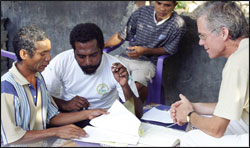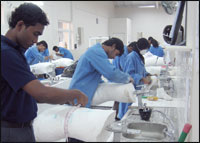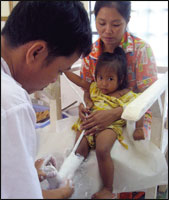
Though recently retired, Peter Carey, MA, PhD, FRHistS, still carries the mien of the quintessential Oxford don – calm, with an intense gaze, immaculate intellect, and a tendency to inject his comments with wry, deft humor. The 60-year-old author and former Laithwaite Fellow in Modern History at Trinity College, University of Oxford, England, is a co-founder of the international powerhouse charity, The Cambodia Trust, a group whose trainees now fit O&P devices on more than 30,000 people every year throughout the developing world. Now, The Cambodia Trust is expanding beyond its current schools and clinics in Cambodia, East Timor, and Sri Lanka and into Indonesia, where Carey now resides. The early-retiree from Oxford is now The Cambodia Trust’s Indonesian country director.
Carey once wrote, “Like many good initiatives, The Cambodia Trust was conceived in a pub…” and he told The O&P EDGE , “if the Grim Reaper doesn’t cut me down before my time, if I don’t make a complete hash of things as country director, then I will have my work cut out for me in Indonesia for the next decade.” The O&P EDGE asked Carey about his journey with The Cambodia Trust and how it has become one of O&P’s greatest humanitarian successes.
Inception
 |
| CSPO Students work in internationally certified labs. |
Carey was born in Rangoon, Burma, in 1948. From age six, he had what he calls “a quite crippling stammer,” that required speech therapy and constant vigilance in public. By 1969, Carey had graduated from Oxford with First Class Honors in modern history, and he then went on to a graduate studentship at Cornell University, Ithaca, New York. After other studies abroad, he returned to Oxford, beginning what would become a three-decade career in which he specialized in the modern history and politics of Burma, East Timor, and Indonesia. In that time, he authored and edited eleven books on Southeast Asian history and politics. Carson Harte, international director of The Cambodia Trust, calls Carey “the most intelligent person I’ve ever known.”
In 1989, Carey and Stan Windass, an international-relations expert whom Carey calls “a great mover and shaker and fixer, a Catholic with a large and a small ‘c’,” were in the Horse and Jockey pub opposite Oxford’s St. Antony’s College. Windass described to Carey the charitable initiative he was about to embark upon – a track-II diplomatic mission to restart Cambodian peace talks. He asked Carey, “You, of course, will be involved, won’t you?” Carey was a natural choice for the plan. He was already serving as a member of Oxfam International’s Asia Committee, he had grown up in Southeast Asia, and he was a practicing Buddhist with a certain sensitivity to local cultural norms. Unfortunately, the diplomatic initiative failed. However, the group’s third co-founder was former British diplomat John Pedler, who had an excellent relationship with the Cambodian government, especially with Cambodian Prime Minister Hun Sen. Hun Sen personally requested that the newly founded Cambodia Trust focus on the needs of his country’s estimated 38,000 landmine survivors. The new project was an even better fit for Carey.
Carey told The O&P EDGE that for him, working in a disability charity “was a personal default setting” partly because “three members of my family lived with quite severe disabilities. My younger son [now deceased] was born a Down’s child and…that very much exposed me to the challenges that disabled people face on a day-to-day basis. My first wife [also deceased] had quite severe postnatal depression and then severe agoraphobia, which led to a quite incapacitating psychotic condition,” and he himself had grown up with the challenges of a stammer.
Early Successes
According to Carey, the Trust initially succeeded due to “luck mainly-at the very least, remarkable coincidence,” but also dedication, initiative, and cooperation among already-established charitable groups, some of which had, as Carey says, already “‘borne the heat and burden of the day’ of serving in an embargoed country.” Harte told The O&P EDGE that in a coordinated effort, the International Committee of the Red Cross (ICRC) was developing polypropylene O&P technology in the area, the American Friends Service Committee (AFSC) was developing a training program for limited-function prosthetic technicians, and Handicap International (HI) was establishing provincial clinics. Separately, the Vietnam Veterans of America Foundation (VVAF) was working with Jaipur technology. Eventually, the Trust embraced polypropylene technology.
 |
| A Cambodian CSPO clinician works on a cast for a pediatric patient. |
Then, Carey recalls, “it became clear in the early ’90s that if Cambodia was going to have the resources to use that technology, then there had to be a training facility, and quite serendipitously at this time, the [AFSC] approached us to take on a project which they felt unable to take to fruition themselves, which was the establishment of a school in Phnom Penh for training prosthetist-orthotists in…polypropylene and extruded aluminum technology, and that was essentially the call to arms which led in 1994 to the establishment of [the Cambodian School of Prosthetics and Orthotics (CSPO)].”
“AFSC joined [the Trust] in setting up CSPO, and it is important they are recognized…,” Harte says. “We all embraced ICRC technology for components, and even the VVAF came on board after dropping their Jaipur technology…. What The Cambodia Trust did, by starting the CSPO, was help to establish a route whereby all the players could collaborate…. By starting P&O training, The Cambodia Trust brought collaboration and sectoral planning to a sector of Cambodian development that was not previously working together.”
History of Triumphs
Since 1994, CSPO has graduated 120 students who hail from more than a dozen developing nations. The Cambodia Trust estimates that each prosthetist-orthotist prescribes 270-300 devices per year, many in CSPO’s rehabilitation centers. In addition, many of CSPO’s first graduates have progressed to teaching or important managerial positions in O&P. The Trust also enjoys what Carey calls “healthy financial support” from donors including the Tokyo-based Nippon Foundation, and “an enviable international reputation.”
Over the years, the Trust grew rapidly, founding schools in East Timor and Sri Lanka, plus sister charities all over the world. Carey has helped maintain the Trust’s strong commitment to project sustainability, emphasizing partnerships with local governments and nongovernmental organizations (NGOs).
Why has Carey taken such great responsibility in the Trust for such a long time? He says, “The very honest answer is that I depended hugely on my other co-founders, especially Stan Windass, who had tremendous experience and knowledge…. Indeed, the Trust was from the beginning a tripartite arrangement between myself, Stan, and John Pedler…and people on the ground who were actually making the project work at the coal-face.”
In November 2008, Carey was awarded the Beacon Prize, which British Prime Minister Gordon Brown called “the Nobel Prize of the Charity World,” for his co-founding of The Cambodia Trust and for leading its expansion in Cambodia and into East Timor, Sri Lanka, and now Indonesia.
Moving into the Future
Carey, as country director in Indonesia, has permanently moved to Jakarta with his wife, Lina, who is Indonesian, and their three-year-old son, Tom, who was born in East Timor. The Indonesian plan is to staff six provincial O&P schools in addition to the one in Jakarta, which may become a Category I school-a university that trains O&P professors. Carey calls the enterprise “a daunting task for the Trust’s next 20 years, and one which proves that all great enterprises come from the heart!”
The Cambodia Trust Launches Indonesia’s First O&P SchoolIn the vast island state of Indonesia, as many as two million people with disabilities lack needed prosthetic and orthotic care. On January 6, The Cambodia Trust and the Indonesian Ministry of Health, with the support of Japan’s Nippon Foundation, signed a memorandum of understanding to address these needs by establishing Indonesia’s first international-standard school of prosthetics and orthotics. |




